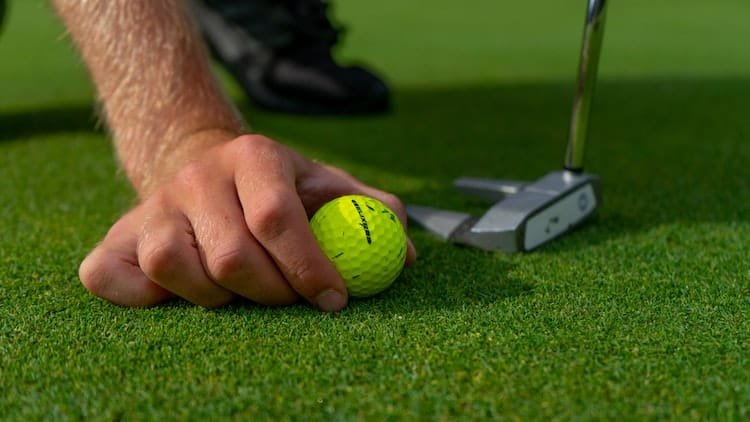Golf putters were not always as complicated as they are today.
For so many years, you could choose a basic blade like the Ping Anser or a half-round mallet, likely made by Odyssey. However, things have changed entirely, and there are now hundreds of putter options to choose from.
Both blade and mallet putters can be effective, and to understand how they will impact your putting stroke, it pays to know the difference.
What is a Blade Putter?

A blade putter is the classic golf putter design. This putter head is usually rectangular in shape with a flat face and a relatively short backing on the club. Blade putters don’t have large clubheads and are more simplistic in design.
Many blade putters will have a small alignment line on the top of the putter head. Professional golfers and better players have been known to like the blade putters because of their precision and feel.
What is a Mallet Putter?

A mallet putter is larger than a blade putter. There is still a flat face on the mallet putter, but the back of the putter head is rounded, or with the modern blade putters, it can even be rectangular in shape.
When mallet putters first came out, they were really simple. It looked like a small semi-circle on the back of a blade.
Since then, the putters have become much more advanced, with putter heads that extend three or four inches past the face of the putter. Mallet putters are known for easy Alignment and consistency, and they are often preferred by golfers learning to play the game.
Main Differences Between a Blade and Mallet Putter
To determine if a blade or mallet putter is best for your game, you have to understand the differences in both the look and the performance of the club.
Forgiveness
The blade and mallet putter will offer forgiveness for off-center hits. You will notice that the mallet putter has a significantly larger sweet spot making it a bit more forgiving.
However, there are some products created by both Ping and Odyssey that specifically worked on creating a higher MOI putter option for a blade style putter. So don’t think that switching to blade putters means you will miss more putts.
The key is finding something that is a specific match to your game. When you want a lot of forgiveness in a putter, look for a high MOI option.
Alignment
All golf putters offer some type of alignment technology. Even if you have your own way of setting up for a shot, Alignment is a key feature that needs to be considered.
Golf purists tend to look down at the golf ball and putter head and want a very short white line that directs their putter head to the hole. However, many amateur and beginner golfers would prefer several lines or thicker and more advanced alignment patterns.
There is no right or wrong answer here regarding Alignment, but if you struggle with lining up properly, the mallet putter has more advanced features on the top of the club head.
Weighting and Feel
With some of these large modern mallet putters, the total weight of the club looks like it is going to be a lot. The good news is that with new lighter materials being used and different golf shaft options, the weight is not all that heavy, and the feel can still be rather light.
It’s a counterintuitive concept in golf, but a lighter putter is often better for slow greens, and a faster putter is better for fast greens.
Many professionals that use a blade style putter will ensure that it is considerably heavier as this is what works well on faster greens. The heavy putter allows for a shorter and more compact stroke, something easier to keep on the proper line.
Stroke Type
One of the biggest indicators of which type of putter to use is the type of stroke that you have. The arc style stroke tends to be the best choice for a blade style putter. The straight back and straight-through stroke types are best for a mallet head putter.
Depending on the stroke type that you have, you will want to be careful which putter you choose. Arc style putting strokes require players to open the clubface slightly on the backswing, square it up through impact, and then rotate it slightly closed on the follow-through.
Straight back and straight through putting strokes, keep the putter head square for the entire time. Distance control tends to be an issue for both types of putting strokes, but it becomes even more of a problem if you are not utilizing the proper type of putter.
Golfers with arc style putter strokes can certainly use a blade putter, but it may be awkward or unnecessary to rotate the face of the putter open and closed on the mallet when you don’t need to.
Golfer Handicap
The old rule of thumb was that better players use blades and higher handicappers use mallet putters. I don’t like this theory, and I don’t think it’s true anymore. Its kind of like higher handicappers or beginners should not use forged clubs, yet companies are putting out new game-improvement forged irons every year.
It’s important to know that many mallet style putters have a larger sweet spot. However, as long as the putter you are using is the proper specifications for your game and you have a high moment of inertia, the handicap should not play into it all that much.
Certain putter designs like an Odyssey 2 Ball putter are certainly more forgiving than something like the Scotty Cameron Newport putter. Don’t choose a putter based on handicap alone; consider the club’s specific features.
Pros and Cons of a Blade Putter
The blade putter certainly has more positives than it does negatives; here are a few of the most important to know.
Pros
- Classic look: the blade style putter is a more classic design; golf purists, lower handicappers, and those that like to keep things simple will certainly like the blade design better.
- Easy To Manipulate The Clubhead: blade putters allow you to rotate the clubhead with ease; for golfers with an arc style putting stroke, this is very important.
- Premium design: many blade putters have milled faces and are forged from one piece of metal, making them a more premium design that favors the feel-oriented player.
- Lower Price: although it is not always the case, many blade putters are more affordable than mallet putters simply because they use less material in their design.
Cons
- Not Great For Alignment: most blade putters have a single alignment line on the top of the club that does not help with lining up shots quite the way you would like it to.
- Smaller Sweet Spot: the more compact size of a blade style putter makes it slightly less helpful from a forgiveness standpoint.
Pros and Cons of a Mallet Putter
Mallet putters continue to have new options released each year. Every time you see a mallet putter that is bigger and better than the options from last year, you may wonder what these companies will come up with next.
Pros
- Easy Alignment: a mallet putter head is very easy to line up; the top of the head just needs to be pointed to the target.
- High MOI: the majority of mallet putters on the market have a high MOI and are more forgiving than blade putters.
- Stability: with the mallet design putter, you can keep the putter on a straight back and straight through the path, and it remains stable at impact; this is why you will see some of this unique shaping in the mallet putters on the market currently.
Cons
- Can Be Bulky: the newer modern mallet designs are huge; if you are coming from a slim blade style putter, expect this to feel a bit cumbersome at first.
- Won’t Rotate Well: for arc style putters, the mallet putter becomes difficult to open and close as you rotate through your putting stroke; this is best for a straight back and straight through putting stroke.
Final Verdict: Deciding on Which Putter You Should Be Using
Hopefully, you now have a bit of a better understanding of the differences between a blade and a mallet-style putter.
If you are looking for forgiveness and like to keep things simple on the putting green, I recommend going with the mallet putter head. You can keep the putter on the same path, make very little movement in your stroke and make some great putts.
For golfers that are more artistic on the greens and want to putt with better feel and control, the blade is a better choice. Think about how you approach putting green and how you see the lines; this will help you make the best choice.
In the end, it’s impossible to say one is better than the other; you just have to find the right match.


